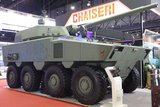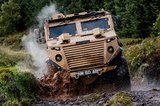Textron delivers bespoke reconnaissance vehicle to US marines
This Cottonmouth variant has been purpose-built as a Naval Sensor Node for the USMC. (Photo: Textron Systems)
Textron delivered a Cottonmouth Advanced Reconnaissance Vehicle to the USMC at the beginning of December.
The vehicle was purpose built to serve as a Naval Sensor Node to support expeditionary operations. The vehicle provides lightweight multi-modal capability for the USMC, aligned with the service’s Force Design 2030 vision.
A multi-domain C2 suite integrated into the vehicle as part of the C4UAS Mission Role Variant fit-out allows it to coordinate data and serve as battlefield manager.
The amphibious 6x6 platform is equipped for sustained reconnaissance with organic uncrewed systems capabilities and multi-spectrum sensors, which provide communication between the USN and USMC.
The Cottonmouth’s footprint also allows rapid transport of four vehicles on a Ship-to-Shore Connector.
The prototype vehicle now enters its formal government evaluation phase, expected to last through 2023. Cottonmouth is Textron's contender for the USMC's Advanced Reconnaissance Vehicle (ARV) requirement.
Related Programmes in Defence Insight
Related Equipment in Defence Insight
More from Land Warfare
-
![Next stage approved for major European robot programme]()
Next stage approved for major European robot programme
The European Commission and Milrem Robotics have signed a grant agreement for iMUGS2, following on from the original iMUGS collaboration to develop modular and scalable architecture for crewed and uncrewed systems.
-
![The British Army’s Land Mobility Programme – all change but no progress?]()
The British Army’s Land Mobility Programme – all change but no progress?
The UK’s Land Mobility Programme, an effort to replace thousands of British Army vehicles, may be about to undergo a radical change in direction.
-
![Supacat and KNDS join forces for British Army vehicle programme]()
Supacat and KNDS join forces for British Army vehicle programme
The Land Mobility Programme is the biggest UK opportunity for the next few decades if it all falls into place. Companies have been filling their dance cards as milestones approach in the hope they are not the mirages of the past.























